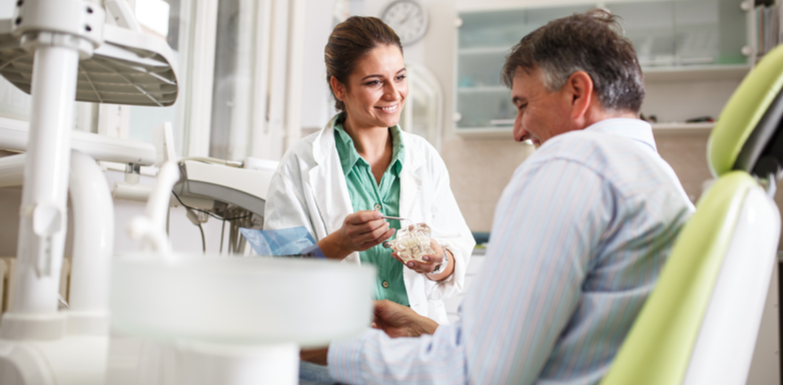Dentists have been involved in the treatment of sleep apnea since dental devices were first found to be effective for the condition in the 1980s. Guidelines for a dentist’s role in the treatment for sleep apnea were put into place in 1995, further cementing their importance. But can dentists help with sleep apnea? Absolutely. Here’s how.
Getting a sleep apnea diagnosis
Sleep apnea affects an estimated 25 million people in the U.S., although these numbers are thought to be an underestimation. In general, there are three main types of sleep apnea.
- Obstructive sleep apnea: The airway becomes blocked by the muscles of the throat and tongue
- Central sleep apnea: A sleeper’s brain essentially “forgets” to send the signal to breathe
- Complex sleep apnea: This dangerous combination of both types and includes a blocked airway and a brain that does not recognize that the sleeper is not breathing
Obstructive sleep apnea is the most common type of sleep apnea, ranging in severity from just a few pauses a night to as many as 30 every hour.
The primary symptoms of sleep apnea are:
- Pauses in breathing followed by a gasping intake of breath
- Snoring
- High blood pressure
- Nighttime sweating unrelated to hormonal fluctuations
- Morning headaches
- Fatigue
- Difficulty concentrating
Sleep apnea is a serious disorder that brings with it an elevated risk of heart disease, stroke, dementia, and even premature death. Because of this, a sleep apnea diagnosis is a crucial first step to successful treatment. This is the first example of how dentists help with this condition.
The American Academy of Sleep Medicine (AASM) and the American Academy of Dental Sleep Medicine (AADSM) both recognize that the most important part of treatment is a proper diagnosis.
In 2012, the AASM and AADSM released a joint statement that a qualified physician must diagnose a patient with sleep apnea. This may include a face-to-face meeting but does not necessarily preclude an at-home sleep apnea test. Dentists may also be one of the first healthcare providers to find evidence of sleep apnea through changes in the patient’s mouth.
Treating sleep apnea
The policy also notes that dentists are legally qualified to treat patients with sleep apnea after a diagnosis. AADSM goes on to state that oral appliance therapy (what is also referred to as sleep apnea dental devices) should be fitted by a qualified dentist, not necessarily a patient’s primary care physician.
Why? Dentists have specialized training in fitting dental devices for the appropriate comfort in a patient’s mouth. Medical professionals from primary care physicians to dentists agree that the best approach to treating sleep apnea is a close relationship between healthcare providers all the way from diagnosis to follow-up after treatment.
Designing sleep apnea dental devices
For severe sleep apnea, the first line treatment has been a continuous positive airway pressure (CPAP) machine. This machine delivers a continuous stream of air to the back of the throat through a mask that fits over the nose, the mouth, or both.
Unfortunately, for many patients, there are barriers to compliance that include the noise of machine and the discomfort of the mask. Further, CPAP machines are challenging to travel with. Finally, they may increase rates of pneumonia and other respiratory conditions that contraindicate their use in some patient populations.
However, research continues to show that sleep apnea dental devices fitted by a qualified dentist are nearly as effective as a CPAP machine simply because they are more comfortable, portable, and easy to use. In practice, nearly 75% of people stop using their CPAP six months (or less) after they begin. The best treatment is one that a patient can stick with.
Your sleep apnea dentist will work closely with you to create a custom-made sleep apnea dental device that is comfortable and easy to use.
Managing other conditions
The dental signs of sleep apnea may include other conditions that you might not necessarily link to sleep disordered breathing. Conditions like temporomandibular joint disorder (TMD/TMJ) and bruxism are bi-directional conditions to sleep apnea. This means that one condition worsens the other. In all three conditions, researchers have not figured out which causes the other conclusively.
Your sleep apnea dentist can spot the dental signs of TMD and bruxism. In many cases, the symptoms are very similar to those that occur with sleep apnea and may include:
- Soreness in the jaw
- Worn tooth enamel
- Tooth sensitivity
- Daytime fatigue
- Morning headache
- Difficulty opening the jaw
- Popping and clicking jaw
Indeed, your dentist may be the first person to suspect any of these conditions. They will ask you about your sleeping habits, including whether or not you snore which is also a risk factor for sleep apnea. They can also consider any other anatomical risk factors for sleep apnea, TMD, or bruxism.
Schedule regular dental care
Avoiding the dentist? Make it your resolution to visit at least twice a year for a check-up. It can help both your ongoing dental and physical health. Your dentist can help diagnose and treat a number of complex health conditions and are uniquely situated to detect potential issues.
AZ Dentist is a sleep apnea dentist with convenient office locations and hours all across the Phoenix Valley. Can dentists help with sleep apnea? Yes, we can! Get in touch today.
